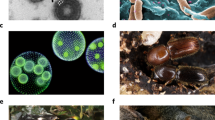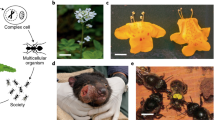Abstract
Obligate relationships have evolved many times and can be parasitic or mutualistic. Obligate organisms rely on others to survive and thus coevolve with their host or partner. An important but little explored question is whether obligate status is an evolutionarily terminal condition or whether obligate lineages can evolve back to an autonomous lifestyle. The bacterium Myxococcus xanthus survives starvation by the social development of spore-bearing fruiting bodies. Some M. xanthus genotypes defective at fruiting body development in isolation can nonetheless exploit proficient genotypes in chimaeric groups. Here we report an evolutionary transition from obligate dependence on an altruistic host to an autonomous mode of social cooperation. This restoration of social independence was caused by a single mutation of large effect that confers fitness superiority over both ancestral genotypes, including immunity from exploitation by the ancestral cheater. Thus, a temporary state of obligate cheating served as an evolutionary stepping-stone to a novel state of autonomous social dominance.
This is a preview of subscription content, access via your institution
Access options
Subscribe to this journal
Receive 51 print issues and online access
$199.00 per year
only $3.90 per issue
Buy this article
- Purchase on Springer Link
- Instant access to full article PDF
Prices may be subject to local taxes which are calculated during checkout






Similar content being viewed by others
References
Pierce, N. E. et al. The ecology and evolution of ant association in the Lycaenidae (Lepidoptera). Annu. Rev. Entomol. 47, 733–771 (2002)
Keeling, P. J. & Fast, N. M. Microsporidia: biology and evolution of highly reduced intracellular parasites. Annu. Rev. Microbiol. 56, 93–116 (2002)
Alexander, J., Satoskar, A. R. & Russell, D. G. Leishmania species: models of intracellular parasitism. J. Cell Sci. 112, 2993–3002 (1999)
Williamson, V. M. & Gleason, C. A. Plant-nematode interactions. Curr. Opin. Plant Biol. 6, 327–333 (2003)
Pellmyr, O. & Krenn, H. W. Origin of a complex key innovation in an obligate insect-plant mutualism. Proc. Natl Acad. Sci. USA 99, 5498–5502 (2002)
Lopez-Vaamonde, C., Rasplus, J. Y., Weiblen, G. D. & Cook, J. M. Molecular phylogenies of fig wasps: partial cocladogenesis of pollinators and parasites. Mol. Phylogenet. Evol. 21, 55–71 (2001)
Moran, N. A. Microbial minimalism: genome reduction in bacterial pathogens. Cell 108, 583–586 (2002)
Moran, N. A. Tracing the evolution of gene loss in obligate bacterial symbionts. Curr. Opin. Microbiol. 6, 512–518 (2003)
Rothstein, S. I. & Robinson, S. K. Parasitic Birds and their Hosts: Studies in Coevolution (Oxford Univ. Press, New York, 1998)
Lorenzi, M. C., Cervo, R., Zacchi, F., Turillazzi, S. & Bagneres, A. G. Dynamics of chemical mimicry in the social parasite wasp Polistes semenowi (Hymenoptera: Vespidae). Parasitology 129, 643–651 (2004)
Sumner, S., Aanen, D. K., Delabie, J. & Boomsma, J. J. The evolution of social parasitism in Acromyrmex leaf-cutting ants: a test of Emery's rule. Insectes Soc. 51, 37–42 (2004)
Cervo, R., Macinai, V., Dechigi, F. & Turillazzi, S. Fast growth of immature brood in a social parasite wasp: A convergent evolution between avian and insect cuckoos. Am. Nat. 164, 814–820 (2004)
Foitzik, S., Fischer, B. & Heinze, J. Arms races between social parasites and their hosts: geographic patterns of manipulation and resistance. Behav. Ecol. 14, 80–88 (2003)
Pellmyr, O. & Thompson, J. N. Multiple occurrences of mutualism in the yucca moth lineage. Proc. Natl Acad. Sci. USA 89, 2927–2929 (1992)
Sorenson, M. D. & Payne, R. B. A single ancient origin of brood parasitism in African finches: implications for host-parasite coevolution. Evol. Int. J. Org. Evol. 55, 2550–2567 (2001)
Dale, C., Wang, B., Moran, N. & Ochman, H. Loss of DNA recombinational repair enzymes in the initial stages of genome degeneration. Mol. Biol. Evol. 20, 1188–1194 (2003)
Maynard Smith, J. & Szathmáry, E. The Major Transitions in Evolution (Freeman Spektrum, Oxford, 1995)
Seidler, R. J. & Starr, M. P. Isolation and characterization of host-independent Bdellovibrios. J. Bacteriol. 100, 769–785 (1969)
Lutzoni, F., Pagel, M. & Reeb, V. Major fungal lineages are derived from lichen symbiotic ancestors. Nature 411, 937–940 (2001)
Dawid, W. Biology and global distribution of myxobacteria in soils. FEMS Microbiol. Rev. 24, 403–427 (2000)
Rosenberg, E. & Varon, M. in Myxobacteria: Development and Cell Interactions (ed. Rosenberg, E.) 109–125 (Springer, New York, 1984)
Wu, S. S. & Kaiser, D. Genetic and functional evidence that Type IV pili are required for social gliding motility in Myxococcus xanthus. Mol. Microbiol. 18, 547–558 (1995)
Shimkets, L. J. Intercellular signaling during fruiting-body development of Myxococcus xanthus. Annu. Rev. Microbiol. 53, 525–549 (1999)
Wireman, J. W. & Dworkin, M. Developmentally induced autolysis during fruiting body formation by Myxococcus xanthus. J. Bacteriol. 129, 796–802 (1977)
Fiegna, F. & Velicer, G. J. Exploitative and hierarchical antagonism in a cooperative bacterium. PLoS Biol. 3, 1980–1987 (2005)
Velicer, G. J., Kroos, L. & Lenski, R. E. Developmental cheating in the social bacterium Myxococcus xanthus. Nature 404, 598–601 (2000)
Rainey, P. B. & Rainey, K. Evolution of cooperation and conflict in experimental bacterial populations. Nature 425, 72–74 (2003)
Sachs, J. L. & Bull, J. J. Experimental evolution of conflict mediation between genomes. Proc. Natl Acad. Sci. USA 102, 390–395 (2005)
Velicer, G. J. & Yu, Y. T. Evolution of novel cooperative swarming in the bacterium Myxococcus xanthus. Nature 425, 75–78 (2003)
Velicer, G. J., Kroos, L. & Lenski, R. E. Loss of social behaviors by Myxococcus xanthus during evolution in an unstructured habitat. Proc. Natl Acad. Sci. USA 95, 12376–12380 (1998)
Dugatkin, L. A., Perlin, M., Lucas, J. S. & Atlas, R. Group-beneficial traits, frequency-dependent selection and genotypic diversity: an antibiotic resistance paradigm. Proc. R. Soc. Lond. B 272, 79–83 (2005)
Greig, D. & Travisano, M. The Prisoner's Dilemma and polymorphism in yeast SUC genes. Proc. R. Soc. Lond. B 271 (Suppl 3), S25–S26 (2004)
Strassmann, J. E., Zhu, Y. & Queller, D. C. Altruism and social cheating in the social amoeba Dictyostelium discoideum. Nature 408, 965–967 (2000)
Velicer, G. J. Social strife in the microbial world. Trends Microbiol. 11, 330–337 (2003)
Velicer, G. J., Lenski, R. E. & Kroos, L. Rescue of social motility lost during evolution of Myxococcus xanthus in an asocial environment. J. Bacteriol. 184, 2719–2727 (2002)
Fiegna, F. & Velicer, G. J. Competitive fates of bacterial social parasites: persistence and self-induced extinction of Myxococcus xanthus cheaters. Proc. R. Soc. Lond. B 270, 1527–1534 (2003)
Frank, S. A. Perspective: repression of competition and the evolution of cooperation. Evol. Int. J. Org. Evol. 57, 693–705 (2003)
Keller, L. Levels of Selection in Evolution (Princeton Univ. Press, Princeton, New Jersey, 1999)
Travisano, M. & Velicer, G. J. Strategies of microbial cheater control. Trends Microbiol. 12, 72–78 (2004)
Foster, K. R., Shaulsky, G., Strassmann, J. E., Queller, D. C. & Thompson, C. R. L. Pleiotropy as a mechanism to stabilize cooperation. Nature 431, 693–696 (2004)
Lenski, R. E., Ofria, C., Pennock, R. T. & Adami, C. The evolutionary origin of complex features. Nature 423, 139–144 (2003)
Velicer, G. J., et al. Comprehensive mutation identification in an evolved bacterial cooperator and its cheating ancestor. Proc. Natl Acad. Sci. USA (in the press)
Vetting, M. W. et al. Structure and functions of the GNAT superfamily of acetyltransferases. Arch. Biochem. Biophys. 433, 212–226 (2005)
Rodriguez, A. M. & Spormann, A. M. Genetic and molecular analysis of cglB, a gene essential for single-cell gliding in Myxococcus xanthus. J. Bacteriol. 181, 4381–4390 (1999)
Orr, H. A. The genetic theory of adaptation: A brief history. Nature Rev. Genet. 6, 119–127 (2005)
Kaiser, D. Social gliding is correlated with the presence of pili in Myxococcus xanthus. Proc. Natl Acad. Sci. USA 76, 5952–5956 (1979)
Wall, D., Kolenbrander, P. E. & Kaiser, D. The Myxococcus xanthus pilQ (sglA) gene encodes a secretin homolog required for Type IV pilus biogenesis, social motility and development. J. Bacteriol. 181, 24–33 (1999)
Bretscher, A. P. & Kaiser, D. Nutrition of Myxococcus xanthus, a fruiting myxobacterium. J. Bacteriol. 133, 763–768 (1978)
Acknowledgements
We thank S. Elena, K. Foster, M. Grbic and our laboratory members for discussions and/or comments on the manuscript. We also thank S. Deiss and H. Keller for technical assistance. This work was partially funded by a grant from the Deutsche Forschungsgemeinschaft. Author Contributions F.F. (primarily) and G.J.V. (secondarily) performed population-level experiments, Y.-T.N.Y performed the analysis of mutation function, S.V.K. performed the real-time PCR analysis and all four authors contributed to writing the paper.
Author information
Authors and Affiliations
Corresponding author
Ethics declarations
Competing interests
Reprints and permissions information is available at npg.nature.com/reprintsandpermissions. The authors declare no competing financial interests.
Rights and permissions
About this article
Cite this article
Fiegna, F., Yu, YT., Kadam, S. et al. Evolution of an obligate social cheater to a superior cooperator. Nature 441, 310–314 (2006). https://doi.org/10.1038/nature04677
Received:
Accepted:
Issue Date:
DOI: https://doi.org/10.1038/nature04677
This article is cited by
-
Allopatric divergence of cooperators confers cheating resistance and limits effects of a defector mutation
BMC Ecology and Evolution (2022)
-
Hidden paths to endless forms most wonderful: ecology latently shapes evolution of multicellular development in predatory bacteria
Communications Biology (2022)
-
Agential thinking
Synthese (2021)
-
Hidden paths to endless forms most wonderful: Complexity of bacterial motility shapes diversification of latent phenotypes
BMC Evolutionary Biology (2020)
-
Slow lane to collectivity
Nature Ecology & Evolution (2020)
Comments
By submitting a comment you agree to abide by our Terms and Community Guidelines. If you find something abusive or that does not comply with our terms or guidelines please flag it as inappropriate.



